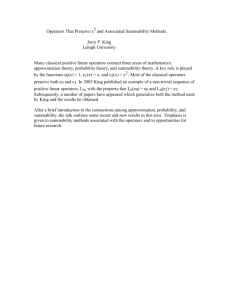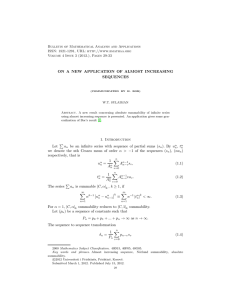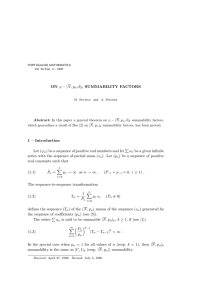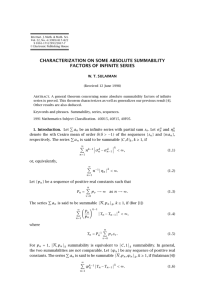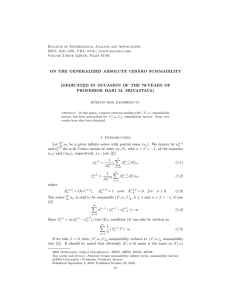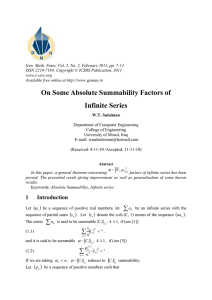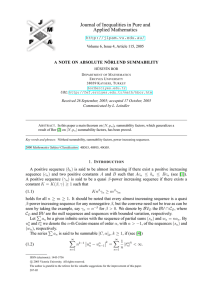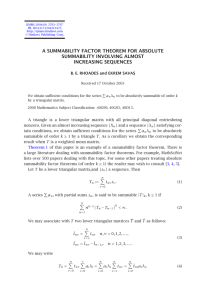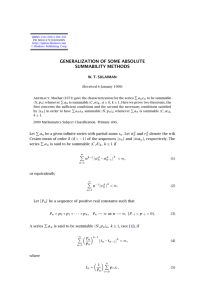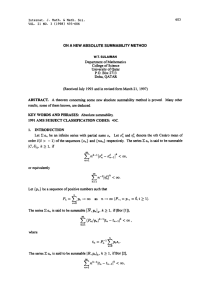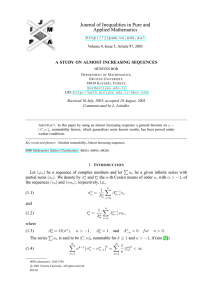Internat. J. Math. & Math. Sci. S0161171200003641 ©Hindawi Publishing Corp.
advertisement
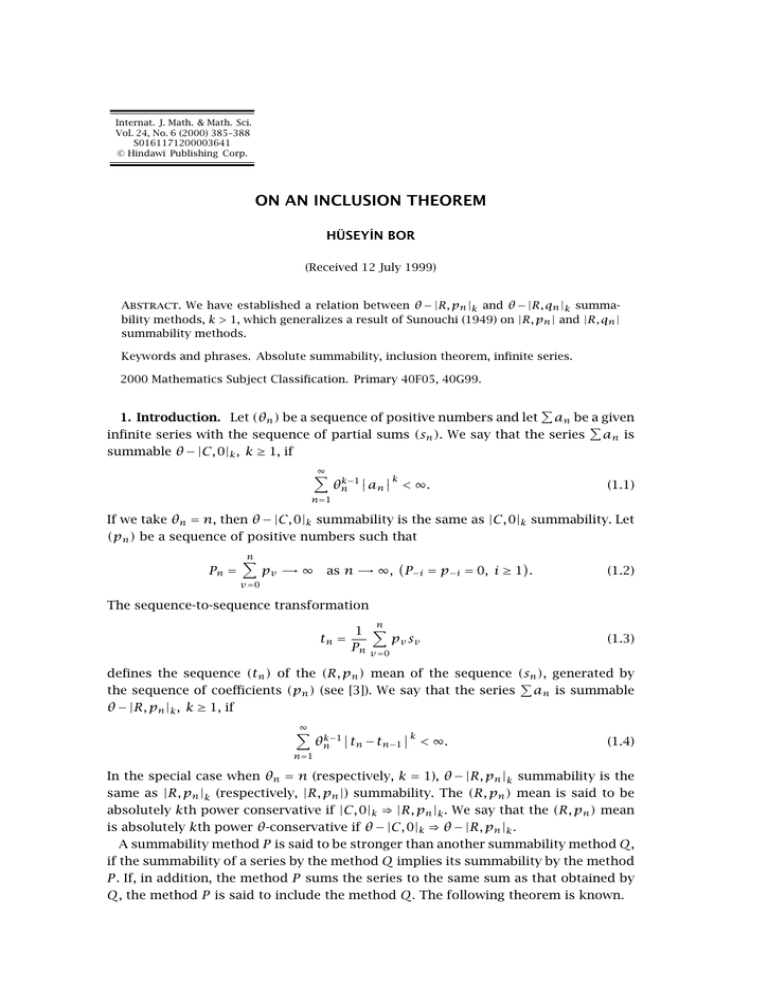
Internat. J. Math. & Math. Sci. Vol. 24, No. 6 (2000) 385–388 S0161171200003641 © Hindawi Publishing Corp. ON AN INCLUSION THEOREM HÜSEYİN BOR (Received 12 July 1999) Abstract. We have established a relation between θ − |R, pn |k and θ − |R, qn |k summability methods, k > 1, which generalizes a result of Sunouchi (1949) on |R, pn | and |R, qn | summability methods. Keywords and phrases. Absolute summability, inclusion theorem, infinite series. 2000 Mathematics Subject Classification. Primary 40F05, 40G99. 1. Introduction. Let (θn ) be a sequence of positive numbers and let an be a given infinite series with the sequence of partial sums (sn ). We say that the series an is summable θ − |C, 0|k , k ≥ 1, if ∞ n=1 k k−1 θn an < ∞. (1.1) If we take θn = n, then θ − |C, 0|k summability is the same as |C, 0|k summability. Let (pn ) be a sequence of positive numbers such that Pn = n pv → ∞ as n → ∞, P−i = p−i = 0, i ≥ 1 . (1.2) v=0 The sequence-to-sequence transformation tn = n 1 pv s v Pn v=0 (1.3) defines the sequence (tn ) of the (R, pn ) mean of the sequence (sn ), generated by the sequence of coefficients (pn ) (see [3]). We say that the series an is summable θ − |R, pn |k , k ≥ 1, if ∞ n=1 k k−1 θn tn − tn−1 < ∞. (1.4) In the special case when θn = n (respectively, k = 1), θ − |R, pn |k summability is the same as |R, pn |k (respectively, |R, pn |) summability. The (R, pn ) mean is said to be absolutely kth power conservative if |C, 0|k ⇒ |R, pn |k . We say that the (R, pn ) mean is absolutely kth power θ-conservative if θ − |C, 0|k ⇒ θ − |R, pn |k . A summability method P is said to be stronger than another summability method Q, if the summability of a series by the method Q implies its summability by the method P . If, in addition, the method P sums the series to the same sum as that obtained by Q, the method P is said to include the method Q. The following theorem is known. 386 HÜSEYİN BOR Theorem 1.1 (see [4]). Suppose that pn > 0, Pn → ∞ and suppose similarly that qn > 0, Qn → ∞. In order that R, pn ⇒ R, qn (1.5) it is sufficient that q n Pn = O(1). pn Qn (1.6) In 1950, while reviewing [4], Bosanquet [2], observed that (1.6) is also necessary for the conclusion and completed Theorem 1.1 in necessary and sufficient form. 2. The main result. The aim of this paper is to generalize Bosanquet’s result for θ − |R, pn |k and θ − |R, qn |k summability, where k ≥ 1. Now, we shall prove the following theorem. Theorem 2.1. Let k > 1. In order that θ − R, pn k ⇒ θ − R, qn k (2.1) should hold (1.6) is necessary. If we suppose that (R, qn ) is “absolutely kth power θ-conservative,” i.e., (2.2) θ − |C, 0|k ⇒ θ − R, qn k , then (1.6) is also sufficient. It should be noted that, if we take k = 1 in this theorem, then we get Bosanquet’s result. Also if we take θn = n, then we get another result related to |R, pn |k and |R, qn |k summability methods. We need the following lemma for the proof of our theorem. Lemma 2.2 (see [1]). Let k ≥ 1 and let A = (anv ) be an infinite matrix. In order that A ∈ (lk , lk ) it is necessary that anv = O(1) (all n, v). (2.3) 3. Proof of the theorem Necessity. For the proof of the necessity, we consider the series-to-series version of (1.3), i.e., for n ≥ 1, let n pn Pv−1 av , Pn Pn−1 v=1 (3.1) n qn Qv−1 av . Qn Qn−1 v=1 (3.2) bn = cn = If we consider (3.1), we have Pn−1 an = Pn Pn−1 Pn−1 Pn−2 bn − bn−1 . pn pn−1 (3.3) 387 ON AN INCLUSION THEOREM Hence an = Pn Pn−2 bn − bn−1 . pn pn−1 (3.4) A simple calculation shows that for n ≥ 1, cn = n−1 bv q n Pn qn bn . Qv−1 Pv − Pv−1 Qv + Qn Qn−1 v=1 pv pn Qn (3.5) 1−1/k From this we can write down at once the matrix A that transforms (θn bn ) into 1−1/k cn ). Thus every θ − |R, pn |k summable series θ − |R, qn |k summable if and only (θn if A ∈ (lk , lk ). By the lemma, it is necessary that the diagonal terms of A must be bounded, which gives that (1.6) must hold. Sufficiency. Let cn,1 denote the sum on the right-hand side of (3.5) and let cn,2 denote the second term on the right-hand side of (3.5). Suppose the conditions are satisfied. Then it is enough to show that if ∞ k k−1 θn bn < ∞, (3.6) k k−1 θn cn,i < ∞ (i = 1, 2). (3.7) n=1 we have ∞ n=1 For i = 2 this is an immediate corollary of (1.6). Now consider i = 1. We have Qv−1 Pv − Pv−1 Qv = −Pv qv + pv Qv = O pv Qv by (1.6). Thus (3.8) n−1 qn Qv bv . cn,1 = O Qn Qn−1 v=1 Now the assumption (2.2) can be stated in the form that if dn = qn Qn Qn−1 n Qv−1 bv , (3.9) bv ∈ θ − |C, 0|k and if (3.10) v=1 then ∞ n=1 Now, define k k−1 θn dn < ∞. 0 (v = 1), bv = b (v ≥ 2). v−1 (3.11) (3.12) If bn ∈ θ−|C, 0|k , then bn ∈ θ − |C, 0|k so applying (2.2) with bn replaced by bn (and making an obvious change of variable in the sum defining dn below) we see that if dn = n qn Qv bv , Qn Qn−1 v=1 (3.13) 388 HÜSEYİN BOR then ∞ n=1 k−1 k θn dn < ∞. (3.14) Hence (3.7) (with i = 1) follows from (3.9). This completes the proof of the theorem. References [1] [2] [3] [4] H. Bor, On the relative strength of two absolute summability methods, Proc. Amer. Math. Soc. 113 (1991), no. 4, 1009–1012. MR 92c:40006. Zbl 743.40007. L. S. Bosanquet, Math. Reviews 11 (1950), 654. G. H. Hardy, Divergent Series, Oxford University Press, 1949. MR 11:25a. Zbl 032.05801. G. Sunouchi, Notes on Fourier analysis. XVIII. Absolute summability of series with constant terms, Tôhoku Math. J. (2) 1 (1949), 57–65. MR 11:654b. Zbl 041.39101. Hüseyi̇n Bor: Department of Mathematics, Erciyes University, 38039 Kayseri, Turkey E-mail address: bor@erciyes.edu.tr
